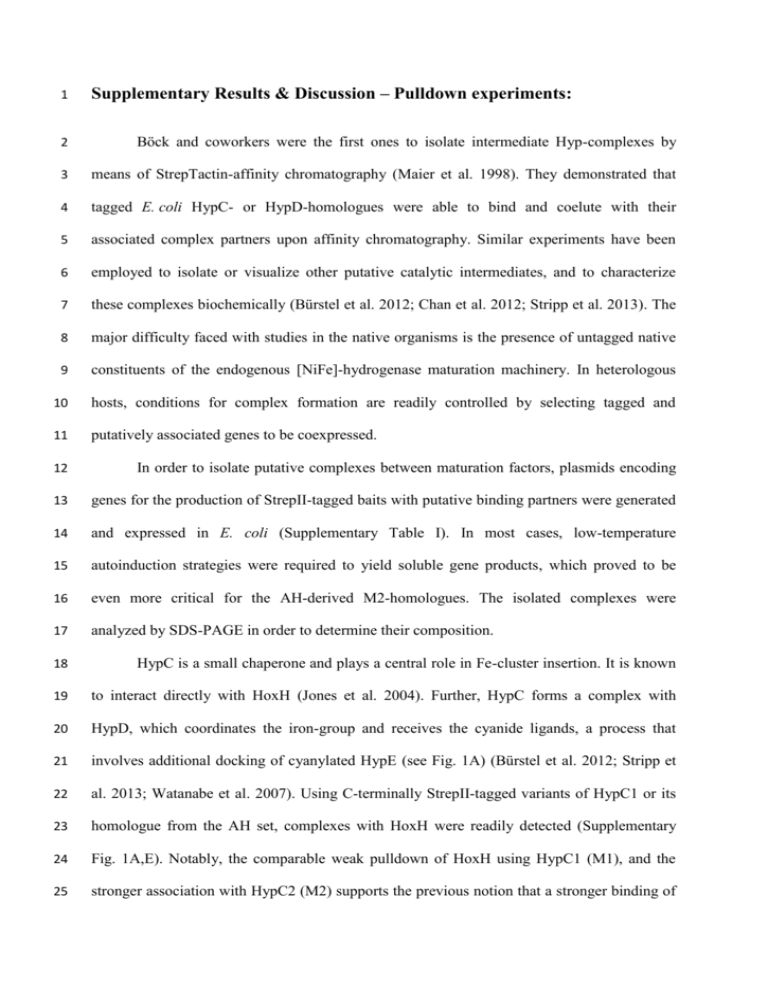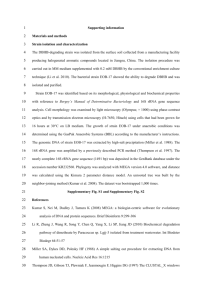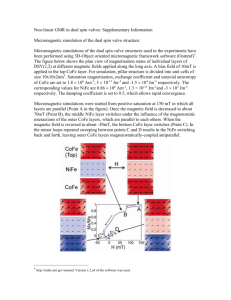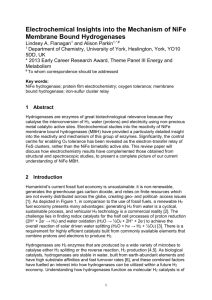bit25658-sup-0001-SupData-S1
advertisement

1 Supplementary Results & Discussion – Pulldown experiments: 2 Böck and coworkers were the first ones to isolate intermediate Hyp-complexes by 3 means of StrepTactin-affinity chromatography (Maier et al. 1998). They demonstrated that 4 tagged E. coli HypC- or HypD-homologues were able to bind and coelute with their 5 associated complex partners upon affinity chromatography. Similar experiments have been 6 employed to isolate or visualize other putative catalytic intermediates, and to characterize 7 these complexes biochemically (Bürstel et al. 2012; Chan et al. 2012; Stripp et al. 2013). The 8 major difficulty faced with studies in the native organisms is the presence of untagged native 9 constituents of the endogenous [NiFe]-hydrogenase maturation machinery. In heterologous 10 hosts, conditions for complex formation are readily controlled by selecting tagged and 11 putatively associated genes to be coexpressed. 12 In order to isolate putative complexes between maturation factors, plasmids encoding 13 genes for the production of StrepII-tagged baits with putative binding partners were generated 14 and expressed in E. coli (Supplementary Table I). In most cases, low-temperature 15 autoinduction strategies were required to yield soluble gene products, which proved to be 16 even more critical for the AH-derived M2-homologues. The isolated complexes were 17 analyzed by SDS-PAGE in order to determine their composition. 18 HypC is a small chaperone and plays a central role in Fe-cluster insertion. It is known 19 to interact directly with HoxH (Jones et al. 2004). Further, HypC forms a complex with 20 HypD, which coordinates the iron-group and receives the cyanide ligands, a process that 21 involves additional docking of cyanylated HypE (see Fig. 1A) (Bürstel et al. 2012; Stripp et 22 al. 2013; Watanabe et al. 2007). Using C-terminally StrepII-tagged variants of HypC1 or its 23 homologue from the AH set, complexes with HoxH were readily detected (Supplementary 24 Fig. 1A,E). Notably, the comparable weak pulldown of HoxH using HypC1 (M1), and the 25 stronger association with HypC2 (M2) supports the previous notion that a stronger binding of 26 non-native HypC-homologues interferes with subsequent steps of maturation, thereby causing 27 reduced processing efficiencies of non-native intermediates (see main body of the article). 28 The tagged HypC baits also formed complexes with HypD-homologues 29 (Supplementary Fig. 1B,F,I). Notably, these complexes were intact, yet inactive in cell-free 30 maturation assays when purified aerobically. The integrity of the corresponding isolates was 31 greatly improved by moving cell-opening and purification steps into an anaerobic glove box. 32 In all cases, elution fractions contained the tagged bait in stoichiometric excess. Fe-cluster 33 assembly and insertion necessitates interactions between HypCD-complexes and cyanylated 34 HypE. In the case of E. coli Hyp-proteins, a stoichiometric HypCDE-complex has previously 35 been isolated (Blokesch 2004). The complexes isolated in this work yielded two dominant 36 species at about 90 and 180 kDa by native PAGE and size-exclusion chromatography, which 37 correspond to monomeric and dimeric forms of the (HypCDE)n-complex (Supplementary Fig. 38 1C and Supplementary Fig. 3). Notably, HypE1 did not coelute with HypC1D1 (M1) unless 39 the hypF gene was coexpressed with hypE. This is in line with the proposal for the E. coli 40 HypCDE-complex that HypE-homologues can only enter a preformed HypCD-complex in 41 their cyanylated (“modified”) form, an event that is crucially preceded by HypF-mediated 42 transcarbamoylation (Blokesch 2004). Interestingly, pulldown of AH-derived HypC2D2E2 43 yielded only trace levels of the complex (Supplementary Fig. 1G), suggesting that the stability 44 of the latter is strongly reduced. 45 Apparently, HypE and HypF do not form a stable complex, as judged by pulldown 46 experiments using either StrepII-tagged HypE- or HypF-variants as baits for coelution of the 47 respective binding partner, which altogether failed to produce isolatable complexes. The 48 HypEF-complex has so far only been detected in an environment containing all other 49 components of the maturation sequence (Blokesch et al. 2004; Jones et al. 2004), or by 50 mixing the two purified proteins after their separate production and isolation (Shomura and 51 Higuchi 2012). Arguably, the complex is transiently formed but subsequently dissociates after 52 completion of the transcarbamoylation-dehydration reactions. In the absence of a preformed 53 Fe-HypCD-complex, HypE-S-C≡N (C-terminally cyanylated HypE) is likely to reside in the 54 cytosol as a dead-end intermediate. 55 For studies of the nickel-insertion complexes, HypB-homologues were used as the 56 tagged baits, which led to the isolation of intact HypAB-complexes of both sets 57 (Supplementary Fig. 1D,H). We further tested, if interactions between parts of the SH- and 58 the AH-set could be stably isolated. This was successful for a stoichiometric complex 59 between StrepII-tagged HypC1 (M1-set) and HypD2 (M2-set) (Fig. 6I). Apart from this 60 interaction, neither the coproduction of tagged baits from the SH-specific set in cells 61 expressing the AH-maturases, nor the production of baits from the latter set in cells producing 62 the former proteins yielded cross reacting material (data not shown). 63 HypX (which is encoded in the MBH-operon of C. necator; Fig. 1B), tagged either C- 64 or N-terminally, was prone to aggregation under all conditions tested. Purification of the 65 soluble protein was not achieved, although trace levels were present in elution fractions (data 66 not shown). Since we found the solubility of many Hyp-proteins to be largely increased by 67 producing them alongside associated complex partners (e. g. HypD-homologues), this might 68 be a requirement for HypX as well. However, the role of HypX in maturation of oxygen- 69 tolerant hydrogenases is currently unknown, as are associated complex partners of the 70 maturase. Studies aiming at the analyses of these assumed interactions are currently on the 71 way. 72 73 74 75 76 Supplementary Results & Discussion – References: 77 Blokesch M. 2004. [NiFe]-Hydrogenasen von Escherichia coli: Funktionen der am 78 Metalleinbau beteiligten Proteine [PhD Thesis]: LMU München. 79 Blokesch M, Paschos A, Bauer A, Reissmann S, Drapal N, Böck A. 2004. Analysis of the 80 transcarbamoylation-dehydration reaction catalyzed by the hydrogenase maturation 81 proteins HypF and HypE. Eur J Biochem 271(16):3428-36. 82 Bürstel I, Siebert E, Winter G, Hummel P, Zebger I, Friedrich B, Lenz O. 2012. A universal 83 scaffold for synthesis of the Fe(CN)2(CO) moiety of [NiFe]-hydrogenase. J Biol Chem 84 287(46):38845-53. 85 Chan KH, Lee KM, Wong KB. 2012. Interaction between hydrogenase maturation factors 86 HypA and HypB is required for [NiFe]-hydrogenase maturation. PLoS One 87 7(2):e32592. 88 Jones AK, Lenz O, Strack A, Buhrke T, Friedrich B. 2004. NiFe hydrogenase active site 89 biosynthesis: identification of Hyp protein complexes in Ralstonia eutropha. 90 Biochemistry 43(42):13467-77. 91 Maier T, Drapal N, Thanbichler M, Böck A. 1998. Strep-tag II affinity purification: an 92 approach to study intermediates of metalloenzyme biosynthesis. Anal Biochem 93 259(1):68-73. 94 Shomura Y, Higuchi Y. 2012. Structural Basis for the Reaction Mechanism of S- 95 Carbamoylation of HypE by HypF in the Maturation of [NiFe]-Hydrogenases. J Biol 96 Chem 287(34):28409-19. 97 Stripp ST, Soboh B, Lindenstrauss U, Braussemann M, Herzberg M, Nies DH, Sawers RG, 98 Heberle J. 2013. HypD Is the Scaffold Protein for Fe-(CN)2CO Cofactor Assembly in 99 [NiFe]-Hydrogenase Maturation. Biochemistry 52(19):3289-96. 100 Watanabe S, Matsumi R, Arai T, Atomi H, Imanaka T, Miki K. 2007. Crystal structures of 101 [NiFe] hydrogenase maturation proteins HypC, HypD, and HypE: insights into 102 cyanation reaction by thiol redox signaling. Mol Cell 27(1):29-40. 103











![[FeFe]- and [NiFe]-hydrogenase diversity, mechanism, and maturation](http://s2.studylib.net/store/data/013550431_1-384b5dce0e961c87cdb6e93c847d8d28-300x300.png)